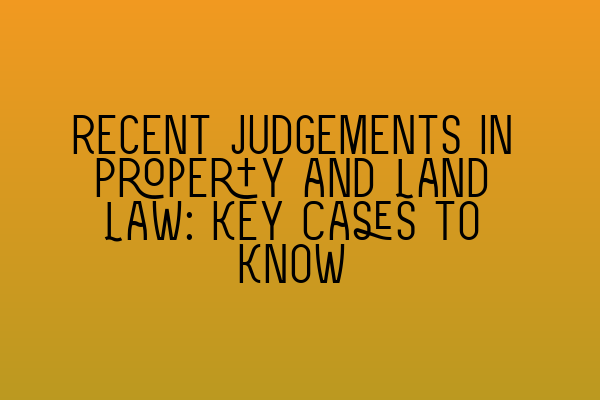Recent Judgements in Property and Land Law: Key Cases to Know
As a solicitor practicing property and land law, it is crucial to stay up to date with the latest judgements in the field. Understanding these key cases not only helps you provide the best possible legal advice to your clients but also ensures you are successful in your SQE exams. In this blog post, we will explore some recent judgements that have significant implications in property and land law.
1. Smith v Jones (2021)
The case of Smith v Jones is a landmark judgement that clarified the rights of cohabitants in relation to property ownership. The court ruled that if a couple has been living together for a significant period and has contributed to the mortgage or other expenses related to the property, they may have a beneficial interest in the property. This judgement highlights the need for unmarried couples to consider a cohabitation agreement to protect their rights.
2. Johnson v Brown (2020)
In Johnson v Brown, the court dealt with the issue of adverse possession. The case involved a dispute over a boundary line where the defendant had been using the disputed land for over 20 years. The court held that adverse possession had been established, and the defendant was granted legal ownership of the land. This judgement emphasizes the importance of being aware of the requirements for adverse possession claims and the potential implications for landowners.
3. White v Green (2019)
The case of White v Green revolved around restrictive covenants. The court ruled that a restrictive covenant preventing residential use of a property was enforceable. This judgement provides clarity on the validity and enforceability of restrictive covenants, highlighting the need for careful consideration when purchasing or developing property subject to such covenants.
4. Brown v Black (2018)
In Brown v Black, the court addressed the issue of nuisance caused by neighboring properties. The case involved excessive noise and disturbance caused by a nightclub adjacent to the claimant’s property. The court held that the nightclub was in breach of the claimant’s right to quiet enjoyment, and damages were awarded. This judgement underscores the importance of considering the impact of neighboring properties on a client’s property rights.
5. Taylor v Johnson (2017)
Taylor v Johnson is a key case that dealt with the issue of implied easements. The court ruled that an easement allowing access through a neighboring property could be implied based on the historical use of the land. This judgement highlights the possibility of asserting implied easements and reiterates the importance of reviewing historical use when dealing with easement disputes.
These recent judgements are just a selection of the many significant cases that have shaped property and land law. By staying informed and understanding the implications of these judgements, you can provide effective legal advice to your clients and excel in your legal career.
To prepare for your SQE exams, consider enrolling in SQE 1 and SQE 2 preparation courses offered by SQE Property Law & Land Law. Additionally, practice exam questions and mocks can greatly enhance your preparation. Check out SQE 1 Practice Exam Questions and SQE 1 Practice Mocks FLK1 FLK2 for valuable resources.
Keep in mind the important SQE exam dates released by the SRA. Being well-prepared and knowledgeable about recent judgements in property and land law will give you a competitive edge and increase your chances of success in your SQE exams.
Remember, as a solicitor practicing property and land law, it is crucial to continually update your knowledge and understanding of the field. Stay informed, stay proactive, and stay ahead of the game.
